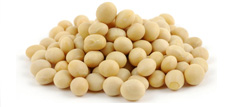







Soy beans
Introduction
There has been a great deal of interest and research into the skin whitening and other cosmetic benefits of soy.
A number of attempts have been made by various researchers, and total soy is now being incorporated into skin care products to improve mottled hyperpigmentation and solar lentigines that frequently result from photodamage.
In addition, soy has been shown to lighten and slow the regrowth of unwanted facial hair. There are many studies showing that fermented soy products containing the isoflavones, daidzein and genistein, may function as weak phytoestrogens. A known biotransformed compound, 6,7,4'-trihydroxyisoflavone, was identified as a potent tyrosinase inhibitor, which has six times the anti-tyrosinase activity of kojic acid.
Mechanism of action
Natural soybeans contain the small proteins, Bowman Birk inhibitor (BBI) and soybean trypsin inhibitor (STI). These serine protease inhibitors inhibit activation of the protease-activated receptor-2 (PAR-2) pathway expressed on keratinocytes. Interference with the PAR-2 pathway has been shown to induce reversible depigmentation by reducing the phagocytosis of melanosomes by keratinocytes, and melanosome transfer. By inhibiting this pathway, reduction of melanin transfer produces a lightening effect. This mechanism of action is different to that of hydroquinone, kojic acid or glabridin. It is important to note that this depigmenting effect is available only with fresh soymilk and not with pasteurized soymilk.
Formulations
Soy is now being formulated alone or in combination with other agents including retinol and sunscreen into cosmeceuticals, particularly moisturizers, to help reduce the signs of photodamage as well as PIH in all skin types.
Studies
A 16-week, double-blind, placebo-controlled, clinical study of African-American, Hispanic, and Asian patients with Fitzpatrick skin types III to V and acne-induced PIH was conducted to determine the safety and efficacy of an OTC anti-acne treatment containing salicylic acid, retinol, and total soy. There was a significant improvement in PIH with the soy formulation from baseline to study endpoint as well as when compared to placebo. Soy-containing products are generally well tolerated. However, more large-scale clinical trials in skin of color are still needed.
In an other study, improvement of hyperpigmentation was seen after 12 weeks of twice-daily application of unpasteurized soy milk, with minimal adverse effects.
>
>
>
>
>
>
>
>
>
>
>
>
>
>
>
>
>
>
>
>
>
>
>
>
>
>
>
>
>
>
>
>
>
>
>
>
>
>
>
>
>
>
>
>
>
>
>
>
>
>
>
TOP 20
Hydroquinone
Monobenzyl Ether of Hydroquinone
Azelaic Acid
Kojic Acid
Arbutin
Retinoids
Mequinol
Niacinamide
Soy
Vitamin C
Corticosteroids
Licorice
Hydroxystilbene
Aloesin
Glutathione
Glycolic Acid
N Acetyl Glucosamine
Gentisic Acid
Green Tea
Melatonin
SKIN WHITENING AGENTS A-Z
a-Hydroxyacids
Aloesin
Alpha Tocopherol and Alpha Tocopherol Ferulate
Arbutin
Azelaic Acid
Centaureidin and Methylophiopogonanone B
Gallic Acid and Derivatives
Gingko
Ginseng
Glutathione
Glycolic Acid
Green Tea
Hesperidin
Hydroquinone
Hydroxycinnamic Acid and Derivatives
Hydroxystilbene
Kojic Acid
Licorice
Linoleic Acid
Magnesium Ascorbyl Phosphate
Melatonin
Mequinol
Monobenzyl Ether of Hydroquinone
Mulberry
N Acetyl Glucosamine
N-Acetyl-4-S-Cysteminylphenol
Niacinamide
Retinoids
Salicylic Acid
Soy
Vitamin C

<< Previous: Salicylic Acid
Next: Vitamin C >>